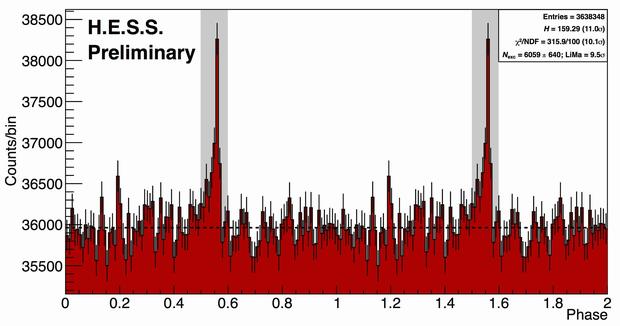The HESS experiment in Namibia is the first Cherenkov system with telescopes of different sizes detecting cosmic TeV gamma rays in sync. A fifth 28-meter telescope, placed at the center of the other four 12-meter telescopes, lowers the energy range under study down to 30 GeV. HESS-II has passed the firing test because scientists have detected a pulsed gamma-ray signal in the energy range of 30 GeV, which they attribute to the Vela pulsar. This paves the way for new observation possibilities of the inner Galaxy.
It isn't just big mirrors that make it possible, HESS included two years of intensive software development. "For the reconstruction of the data from the 28-meter telescope, we performed a highly sensitive analysis based on extremely complex algorithms. For the first time, this allowed us to detect gamma radiation of only 30 GeV from ground level," explains, Mathieu de Naurois, CNRS researcher at the Laboratoire Leprince-Ringuet (CNRS/Ecole Polytechnique) and deputy director of the HESS collaboration. "Since we are able to survey a projected area of 10 hectares in the atmosphere, we have a considerably higher yield of gamma rays than the largest satellite experiments such as Fermi." From some sources, it is possible to spot up to one gamma per second - a record.

Periodic gamma ray pulses of the Vela pulsar in the data obtained by the HESS experiment. One phase is equivalent to 89 milliseconds. © collaboration H.E.S.S.
"The data reveals regular gamma ray pulses at a frequency of 89 milliseconds, coming exactly from the direction of the Vela pulsar. According to our preliminary analyses, everything suggests that these are gamma rays in the energy range of 30 GeV," says Arache Djannati-Ataï from the Laboratoire Astroparticule et cosmologie (CNRS/Université Paris Diderot/CEA/Observatoire de Paris) who, together with his colleagues within the HESS collaboration, tested the reconstruction analysis for the first time.
The Milky Way is full of pulsars and HESS-II seeks to explore its very center. The project is an international collaboration involving more than 180 scientists from 42 research institutes based in 14 countries.





Comments